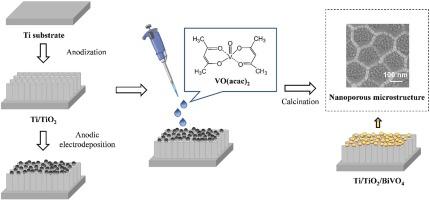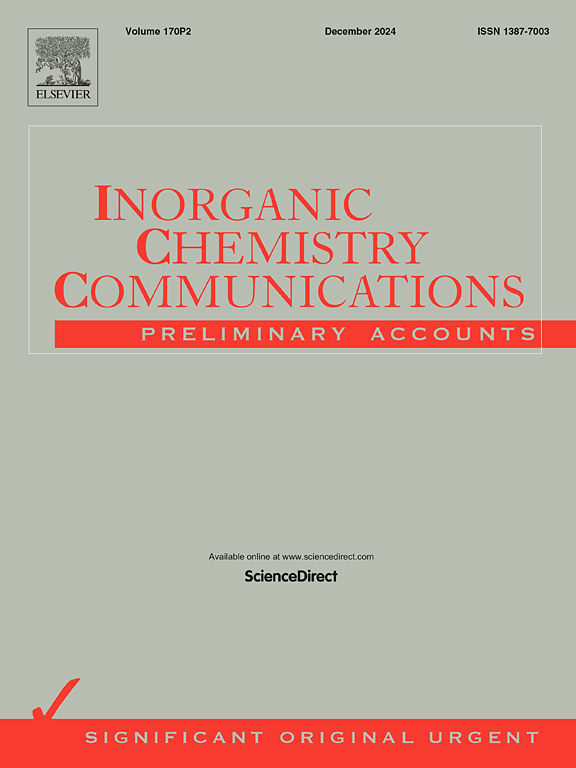A simple preparation method of Ti/TiO2/BiVO4 and implications for enhanced photoelectrocatalytic performance under visible light illumination
IF 5.4
3区 化学
Q1 CHEMISTRY, INORGANIC & NUCLEAR
引用次数: 0
Abstract
A minimalist approach to fabricate the synthetic composite Ti/TiO2/BiVO4 was proposed. Concurrently, the photoelectrocatalytic performance and activity of the Ti/TiO2/BiVO4 electrode were evaluated. Specifically, the relationship between composition, morphology, and photocurrent response was initially discussed. Then, the transient photocurrent, linear sweep voltammetry, photoconversion efficiency, and electrochemical impedance spectroscopy were employed to test the photoelectrochemical performance. To evaluate the photoelectrocatalytic activity of this composite electrode, rhodamine B (RhB) degradation under optimized experimental conditions was selected as a typical case study. Compared with other similar electrodes, the present electrode had a short preparation time, excellent photocurrent response, high RhB removal, and high stability. Based on the measurements of trapping experiments, Mott−Schottky spectroscopy (M−S), UV–visible diffuse reflectance spectra (UV–Vis DRS), electron paramagnetic resonance (EPR), and degradation intermediate products, a possible photoelectrocatalytic degradation mechanism of Ti/TiO2/BiVO4 was proposed. According to our results, ·O2− should be the dominant oxidative species. The Z-scheme heterojunction of Ti/TiO2/BiVO4 has a new microstructure with potential in wastewater treatment.

Ti/TiO2/BiVO4 的简单制备方法及其对提高可见光照射下光电催化性能的影响
提出了一种制造合成复合 Ti/TiO2/BiVO4 的简约方法。同时,对 Ti/TiO2/BiVO4 电极的光电催化性能和活性进行了评估。具体来说,首先讨论了组成、形态和光电流响应之间的关系。然后,采用瞬态光电流、线性扫描伏安法、光电转换效率和电化学阻抗谱来测试光电化学性能。为了评估该复合电极的光电催化活性,选择了在优化实验条件下降解罗丹明 B(RhB)作为典型案例研究。与其他同类电极相比,该电极具有制备时间短、光电流响应好、RhB 去除率高和稳定性高等特点。根据捕集实验、莫特-肖特基光谱(M-S)、紫外可见光漫反射光谱(UV-Vis DRS)、电子顺磁共振(EPR)和降解中间产物的测量结果,提出了 Ti/TiO2/BiVO4 可能的光电催化降解机理。根据我们的研究结果,-O2- 应该是主要的氧化物种。Ti/TiO2/BiVO4 的 Z 型异质结具有新的微观结构,在废水处理方面具有潜力。
本文章由计算机程序翻译,如有差异,请以英文原文为准。
求助全文
约1分钟内获得全文
求助全文
来源期刊

Inorganic Chemistry Communications
化学-无机化学与核化学
CiteScore
5.50
自引率
7.90%
发文量
1013
审稿时长
53 days
期刊介绍:
Launched in January 1998, Inorganic Chemistry Communications is an international journal dedicated to the rapid publication of short communications in the major areas of inorganic, organometallic and supramolecular chemistry. Topics include synthetic and reaction chemistry, kinetics and mechanisms of reactions, bioinorganic chemistry, photochemistry and the use of metal and organometallic compounds in stoichiometric and catalytic synthesis or organic compounds.
 求助内容:
求助内容: 应助结果提醒方式:
应助结果提醒方式:


